#vistula–oder offensive
Text

Des soldats allemands combattent l'avancée des forces soviétiques dans les mines de charbon près de la ville de Gleiwitz en Haute-Silésie (aujourd'hui Gliwice) – Offensive Vistule-Oder – Pologne – 23 janvier 1945
#WWII#front est#eastern front#offensive vistule-oder#vistula–oder offensive#armée allemande#german army#wehrmacht#heer#gleiwitz#gliwice#pologne#poland#23/01/1945#01/1945#1945
20 notes
·
View notes
Text
1974-Georgy Zhukov

Georgy Konstantinovich Zhukov (Russian: Георгий Константинович Жуков; 1 December 1896 – 18 June 1974) was a Marshal of the Soviet Union. He also served as Chief of the General Staff, Minister of Defence, and was a member of the Presidium of the Communist Party (later Politburo). During World War II, Zhukov oversaw some of the Red Army's most decisive victories.
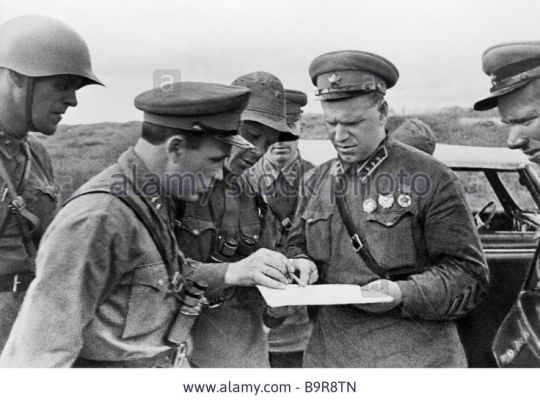


He served in the Red Army during the Russian Civil War. Gradually rising through the ranks, by 1939 Zhukov had been given command of an army group and won a decisive battle over Japanese forces at Khalkhin Gol, for which he won the first of his four Hero of the Soviet Union awards. In February 1941, Zhukov was appointed as chief of the Red Army's General Staff.

In 1945, Zhukov commanded the 1st Belorussian Front; he took part in the Vistula–Oder Offensive, and the Battle of Berlin, which resulted in the defeat of Nazi Germany, and the end of the war in Europe. In recognition of Zhukov's role in the war, he was chosen to accept the German Instrument of Surrender, and inspect the Moscow Victory Parade of 1945.

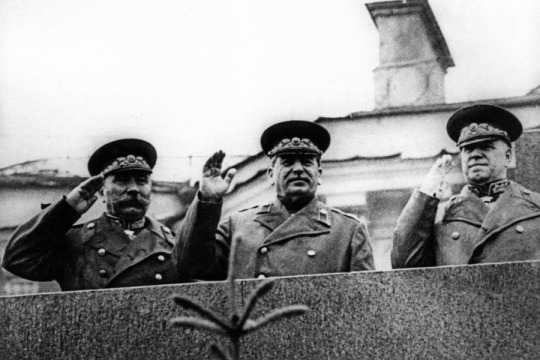

After the war, Zhukov's success and popularity caused Joseph Stalin to see him as a potential threat.[1] Stalin stripped him of his positions and relegated him to military commands of little strategic significance. After Stalin's death in 1953, Zhukov supported Nikita Khrushchev's bid for Soviet leadership. In 1955, he was appointed as Defence Minister and made a member of the Presidium.

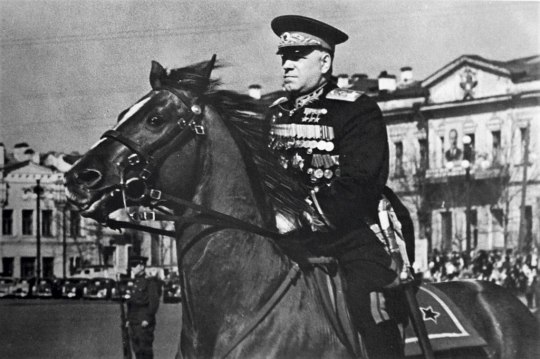

In 1957, Zhukov lost favour again and was forced to retire. He never returned to a position of influence and died in 1974. Zhukov is remembered as one of the greatest Russian and Soviet military leaders of all time, along with Alexander Suvorov and Mikhail Kutuzov.
8 notes
·
View notes
Text
Events 1.17
38 BC – Octavian divorces his wife Scribonia and marries Livia Drusilla, ending the fragile peace between the Second Triumvirate and Sextus Pompey.
1362 – Saint Marcellus' flood kills at least 25,000 people on the shores of the North Sea.
1377 – Pope Gregory XI reaches Rome, after deciding to move the Papacy back to Rome from Avignon.
1524 – Giovanni da Verrazzano sets sail westward from Madeira to find a sea route to the Pacific Ocean.
1562 – France grants religious toleration to the Huguenots in the Edict of Saint-Germain.
1595 – During the French Wars of Religion, Henry IV of France declares war on Spain.
1608 – Emperor Susenyos I of Ethiopia surprises an Oromo army at Ebenat; his army reportedly kills 12,000 Oromo at the cost of 400 of his men.
1648 – England's Long Parliament passes the "Vote of No Addresses", breaking off negotiations with King Charles I and thereby setting the scene for the second phase of the English Civil War.
1649 – The Second Ormonde Peace creates an alliance between the Irish Royalists and Confederates during the War of the Three Kingdoms. The coalition was then decisively defeated during the Cromwellian conquest of Ireland.
1773 – Captain James Cook leads the first expedition to sail south of the Antarctic Circle.
1781 – American Revolutionary War: Battle of Cowpens: Continental troops under Brigadier General Daniel Morgan defeat British forces under Lieutenant Colonel Banastre Tarleton at the battle in South Carolina.
1799 – Maltese patriot Dun Mikiel Xerri, along with a number of other patriots, is executed.
1811 – Mexican War of Independence: In the Battle of Calderón Bridge, a heavily outnumbered Spanish force of 6,000 troops defeats nearly 100,000 Mexican revolutionaries.
1852 – The United Kingdom signs the Sand River Convention with the South African Republic.
1873 – A group of Modoc warriors defeats the United States Army in the First Battle of the Stronghold, part of the Modoc War.
1885 – A British force defeats a large Dervish army at the Battle of Abu Klea in the Sudan.
1893 – Lorrin A. Thurston, along with the Citizens' Committee of Public Safety, led the Overthrow of the Kingdom of Hawaii and the government of Queen Liliʻuokalani.
1899 – The United States takes possession of Wake Island in the Pacific Ocean.
1903 – El Yunque National Forest in Puerto Rico becomes part of the United States National Forest System as the Luquillo Forest Reserve.
1904 – Anton Chekhov's The Cherry Orchard receives its premiere performance at the Moscow Art Theatre.
1912 – British polar explorer Captain Robert Falcon Scott reaches the South Pole, one month after Roald Amundsen.
1915 – Russia defeats Ottoman Turkey in the Battle of Sarikamish during the Caucasus Campaign of World War I.
1917 – The United States pays Denmark $25 million for the Virgin Islands.
1918 – Finnish Civil War: The first serious battles take place between the Red Guards and the White Guard.
1920 – Alcohol Prohibition begins in the United States as the Volstead Act goes into effect.
1941 – Franco-Thai War: Vichy French forces inflict a decisive defeat over the Royal Thai Navy.
1943 – World War II: Greek submarine Papanikolis captures the 200-ton sailing vessel Agios Stefanos and mans her with part of her crew.
1944 – World War II: Allied forces launch the first of four assaults on Monte Cassino with the intention of breaking through the Winter Line and seizing Rome, an effort that would ultimately take four months and cost 105,000 Allied casualties.
1945 – World War II: The Vistula–Oder Offensive forces German troops out of Warsaw.
1945 – The SS-Totenkopfverbände begin the evacuation of the Auschwitz concentration camp as the Red Army closes in.
1945 – Swedish diplomat Raoul Wallenberg is taken into Soviet custody while in Hungary; he is never publicly seen again.
1946 – The UN Security Council holds its first session.
1948 – The Renville Agreement between the Netherlands and Indonesia is ratified.
1950 – The Great Brink's Robbery: Eleven thieves steal more than $2 million from an armored car company's offices in Boston.
1950 – United Nations Security Council Resolution 79 relating to arms control is adopted.
1961 – U.S. President Dwight D. Eisenhower delivers a televised farewell address to the nation three days before leaving office, in which he warns against the accumulation of power by the "military–industrial complex" as well as the dangers of massive spending, especially deficit spending.
1961 – Former Congolese Prime Minister Patrice Lumumba is murdered in circumstances suggesting the support and complicity of the governments of Belgium and the United States.
1966 – Palomares incident: A B-52 bomber collides with a KC-135 Stratotanker over Spain, killing seven airmen, and dropping three 70-kiloton nuclear bombs near the town of Palomares and another one into the sea.
1969 – Black Panther Party members Bunchy Carter and John Huggins are killed during a meeting in Campbell Hall on the campus of UCLA.
1977 – Capital punishment in the United States resumes after a ten-year hiatus, as convicted murderer Gary Gilmore is executed by firing squad in Utah.
1981 – President of the Philippines Ferdinand Marcos lifts martial law eight years and five months after declaring it.
1991 – Gulf War: Operation Desert Storm begins early in the morning as aircraft strike positions across Iraq, it is also the first major combat sortie for the F-117. LCDR Scott Speicher's F/A-18C Hornet from VFA-81 is shot down by a Mig-25 and is the first American casualty of the War. Iraq fires eight Scud missiles into Israel in an unsuccessful bid to provoke Israeli retaliation.
1991 – Crown prince Harald V of Norway becomes King Harald V, following the death of his father, King Olav V.
1992 – During a visit to South Korea, Japanese Prime Minister Kiichi Miyazawa apologizes for forcing Korean women into sexual slavery during World War II.
1994 – The 6.7 Mw Northridge earthquake shakes the Greater Los Angeles Area with a maximum Mercalli intensity of IX (Violent), leaving 57 people dead and more than 8,700 injured.
1995 – The 6.9 Mw Great Hanshin earthquake shakes the southern Hyōgo Prefecture with a maximum Shindo of VII, leaving 5,502–6,434 people dead, and 251,301–310,000 displaced.
1996 – The Czech Republic applies for membership in the European Union.
1997 – Cape Canaveral Air Force Station: A Delta II carrying the GPS IIR-1 satellite explodes 13 seconds after launch, dropping 250 tons of burning rocket remains around the launch pad.
1998 – Clinton–Lewinsky scandal: Matt Drudge breaks the story of the Bill Clinton–Monica Lewinsky affair on his Drudge Report website.
2002 – Mount Nyiragongo erupts in the Democratic Republic of the Congo, displacing an estimated 400,000 people.
2007 – The Doomsday Clock is set to five minutes to midnight in response to North Korea's nuclear testing.
2010 – Rioting begins between Muslim and Christian groups in Jos, Nigeria, results in at least 200 deaths.
2013 – Former cyclist Lance Armstrong confesses to his doping in an airing of Oprah's Next Chapter.
2016 – President Barack Obama announces the Joint Comprehensive Plan of Action.
2017 – The search for Malaysia Airlines Flight 370 is announced to be suspended.
2 notes
·
View notes
Text
LT. NINA LOBKOVSKAYA // SNIPER
“She served as a sniper for the Red Army and attained the rank of Lieutenant in a separate sniper unit of the 3rd Shock Army during WWII. In the war, she reached 89 confirmed kills, making her one of the deadliest women snipers of the war. She participated in the Vistula-Oder Offensive and the Battle of Berlin, awarded the Order of the Red Banner.”

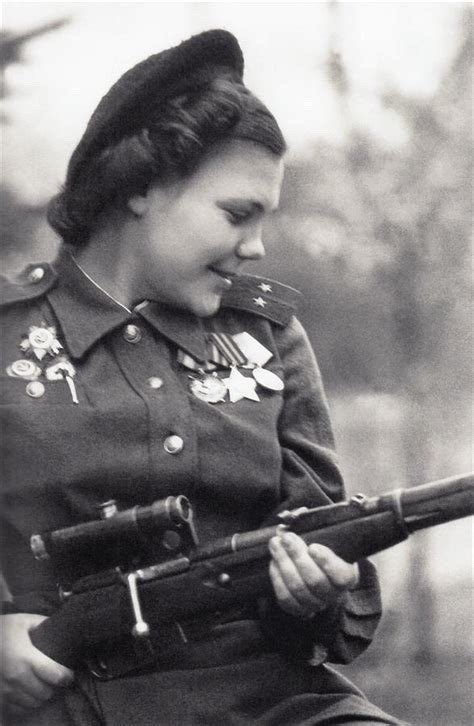
0 notes
Photo
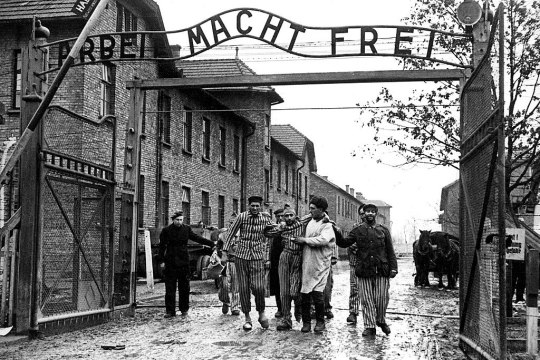
On 27 January 1945, Auschwitz concentration camp—a Nazi concentration camp where more than a million people were murdered—was liberated by the Red Army during the Vistula–Oder Offensive. Although most of the prisoners had been forced onto a death march, about 7,000 had been left behind. The Soviet soldiers attempted to help the survivors and were shocked at the scale of Nazi crimes.
Between 1940 and 1945, about 1.3 million people (mostly Jews) were deported to Auschwitz by Nazi Germany; 1.1 million were murdered. In August 1944, there were more than 135,000 prisoners across the complex. In January 1945, after the Red Army launched the Vistula–Oder Offensive and approached the camp, almost 60,000 prisoners were forced to leave on a death march westward.
Inmates were marched mostly to Loslau but also to Gleiwitz, where they were forced into Holocaust trains and transported to concentration camps in Germany. However, the liberation of the camp was not a specific goal of the Red Army and happened as a consequence of their advance westward across Poland. The Red Army had already liberated concentration camps in the Baltic area in early- to mid-1944, and other concentration camps continued to be liberated until the German surrender and the end of World War II in Europe in May 1945.
Red Army soldiers from the 322nd Rifle Division arrived at Auschwitz on 27 January 1945 at 15:00. Two hundred and thirty-one Red Army soldiers died in the fighting around Monowitz concentration camp, Birkenau, and Auschwitz I, as well as the towns of Oświęcim and Brzezinka. For most of the survivors, there was no definite moment of liberation. After the death march away from the camp, the SS-TV guards had left.
About 7,000 prisoners had been left behind, most of whom were seriously ill due to the effects of their imprisonment. Most of those left behind were middle-aged adults or children younger than 15. Red Army soldiers also found 600 corpses, 370,000 men’s suits, 837,000 articles of women’s clothing, and seven tonnes (7.7 tons) of human hair. At Monowitz camp, there were about 800 survivors and the camp was liberated also on 27 January by the Soviet 60th Army, part of the 1st Ukrainian Front.
Battle-hardened soldiers who were used to death were shocked by the Nazis’ treatment of prisoners. Red Army general Vasily Petrenko, commander of the 107th Infantry Division, remarked, “I who saw people dying every day was shocked by the Nazis’ indescribable hatred toward the inmates who had turned into living skeletons. I read about the Nazis’ treatment of Jews in various leaflets, but there was nothing about the Nazis’ treatment of women, children, and old men. It was in Auschwitz that I found out about the fate of the Jews." In a few articles in Soviet newspapers such as Pravda, following Soviet propaganda, failed to mention Jews in their articles on the liberation.
As soon as they arrived, the liberating forces (assisted by the Polish Red Cross) tried to help survivors by organizing medical care and food; Red Army hospitals cared for 4,500 survivors. There were also efforts to document the camp. As late as June 1945, there were still 300 survivors at the camp who were too weak to be moved.
The date of the liberation (27 January) is recognized by the United Nations and the European Union as International Holocaust Remembrance Day.
📷 Photo above: Soviet soldiers liberating Auschwitz concentration camp
Daily inspiration. Discover more photos at http://justforbooks.tumblr.com
18 notes
·
View notes
Text
On this Day in History - Auschwitz was liberated! On 27 January 1945, Auschwitz concentration camp—a Nazi concentration camp where more than a million people were murdered—was liberated by the Red Army during the Vistula–Oder Offensive. Although most of the prisoners had been forced onto a death march, about 7,000 had been left behind.

5 notes
·
View notes
Photo



Some major events that occurred on January 17.
Photo One: The Germans are forced out of Warsaw as a result of the Vistula-Oder Offensive, 1945.
Photo Two: Raoul Wallenberg is taken into custody of the Soviets, he is never seen again, 1945.
Photo Three: Upon the death of his father, King Olav V, Crown Prince Harald becomes king, 1991.
#this day in history series#history#world war ii#end of the war#vistula-oder offensive#raoul wallenberg#norwegian royal family#king olav v#king harald v
0 notes
Photo


Now on www.propagandaworld.org
Watch with the image of general Georgy Zhukov. In good working order. Made in 1995 to commemorate the 50th. anniversary of the defeat of Nazi Germany.
Georgy Konstantinovich Zhukov (1896-1974) was a Soviet general and Marshal of the Soviet Union. During the Second World War, Zhukov oversaw some of the Red Army’s most decisive victories. Born to a poor peasant family from central Russia, Zhukov was conscripted into the Imperial Russian Army and fought in the First World War. He served in the Red Army during the Russian Civil War.
Gradually rising through the ranks, by 1939 Zhukov was given command of an army group and won a decisive battle over Japanese forces at Khalkhin Gol, for which he won the first of his four Hero of the Soviet Union awards. Following the German invasion of the Soviet Union, Zhukov lost his position as chief of the general staff. Subsequently, he organized the defense of Leningrad, Moscow, and Stalingrad. He participated in planning several major offensives, including the Battle of Kursk and Operation Bagration. In 1945, Zhukov commanded the 1st Belorussian Front; he took part in the Vistula–Oder Offensive and the Battle of Berlin, which resulted in the defeat of Nazi Germany, and the end of the war in Europe. In recognition of Zhukov’s role in the war, he was chosen to accept the German Instrument of Surrender.
4 notes
·
View notes
Text
The Kursk campaign was more decisive than Stalingrad in other ways also. It was the Red Army's first major summer offensive, and the Germans' last. After Stalingrad Manstein had mounted a successful large-scale counteroffensive; after Kursk no German general could. From now on the Red Army had overwhelming superiority in men, tanks, guns, and aircraft, and would lunge from river to river, Dnepr to Vistula to Oder to Elbe, to meet the British and Americans. The enormous losses of 1941 had made the 'Russian steamroller' a myth. Kursk restored it, and it became ever stronger, as territorial gains provided more recruits, while Germany's ability to replace losses declined, and its allies began melting away.
Jukes, Geoffrey, "The Second World War (5): The Eastern Front 1941-45," 2002
5 notes
·
View notes
Text
74 years ago today, Soviet troops together with the 1st Army of the Polish Army liberated Warsaw in the course of the Vistula-Oder offensive operation. On the night of January 17, the military forced into the Vistula, in the morning Soviet-Polish soldiers broke into the city. By 12 o'clock Warsaw was completely rid of the fascist invaders.

#poland#communism#marxism#boleslaw Bierut#bolesław bierut#Komunistyczna Partia Polski#komunistyczna#komunizmu#marxism leninism#marksizmu leninizmu#marksizm#marksizmu#lenin#leninizmu#Władysław Gomułka#Polska Partia Robotnicza#Polska Zjednoczona Partia Robotnicza#polski
4 notes
·
View notes
Photo
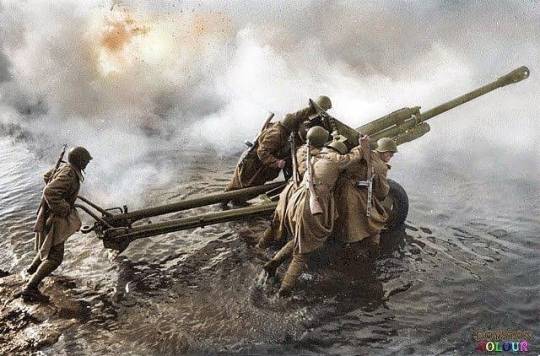
Soviet artillerymen transporting a 76-mm divisional gun M1942 (ZiS-3) during the forced crossing of the Oder River, Germany, c. December, 1944. . The Battle of the Oder–Neisse is the German name for the initial (operational) phase of one of the last two strategic offensives conducted by the Red Army in the Campaign in Central Europe (1 January – 9 May 1945) during World War II. Its initial breakthrough phase was fought over four days, from 16 April until 19 April 1945, within the larger context of the Battle of Berlin. . The battle included heavy fighting by the three Fronts of the Marshals of Soviet Union Konstantin Rokossovsky's 2nd Belorussian Front, Georgy Zhukov's 1st Belorussian Front and Ivan Konev's 1st Ukrainian Front, that assaulted the defending Wehrmacht Army Group Vistula commanded by Colonel-General (Generaloberst) Gotthard Heinrici and Field Marshal Ferdinand Schörner's Army Group Centre. . By the end of 19 April, the German eastern front line north of Frankfurt around the Seelow and to the south around Frost had ceased to exist. These breakthroughs allowed the two Red Army Fronts to envelop large parts of the German 9th and 4th Panzer Armies in a large pocket 37 km east of Frankfurt that attempted to follow the Oder-Spree Canal to Berlin. Attempts by the 9th Army to break out to the west would result in the Battle of Halbe. . The cost to the Red Army in making this initial breakthrough was very high. Between 1 April and 19 April, the Red Army lost over 2,807 tanks. During the same period, the Allies in the west lost 1,079 tanks. . (Photograph by Dmitri Baltermants. Colorized by Royston Leonardfrom the UK) https://www.instagram.com/p/Bn1j0C7Cp8L/?utm_source=ig_tumblr_share&igshid=hkvtcoubzypv
23 notes
·
View notes
Text
Events 2.14 (after 1930)
1939 – World War II: German battleship Bismarck is launched.
1942 – World War II: Battle of Pasir Panjang contributes to the fall of Singapore.
1943 – World War II: Rostov-on-Don, Russia is liberated.
1943 – World War II: Tunisia Campaign: General Hans-Jürgen von Arnim's Fifth Panzer Army launches a counter-attack against Allied positions in Tunisia.
1944 – World War II: In the action of 14 February 1944, a Royal Navy submarine sinks a German-controlled Italian Regia Marina submarine in the Strait of Malacca.
1945 – World War II: On the first day of the bombing of Dresden, the British Royal Air Force and the United States Army Air Forces begin fire-bombing Dresden.
1945 – World War II: Navigational error leads to the mistaken bombing of Prague, Czechoslovakia by a United States Army Air Forces squadron of B-17s assisting in the Soviet Red Army's Vistula–Oder Offensive.
1945 – World War II: Mostar is liberated by Yugoslav partisans
1945 – President Franklin D. Roosevelt meets King Ibn Saud of Saudi Arabia aboard the USS Quincy, officially beginning U.S.-Saudi diplomatic relations.
1946 – The Bank of England is nationalized.
1947 – The act abolishing all noble ranks and related styles comes into force in Hungary.
1949 – The Knesset (parliament of Israel) convenes for the first time.
1949 – The Asbestos Strike begins in Canada. The strike marks the beginning of the Quiet Revolution in Quebec.
1954 – First Indochina war - small French garrison at Đắk Đoa is overrun by the Viet Minh after a week's siege.
1961 – Discovery of the chemical elements: Element 103, Lawrencium, is first synthesized at the University of California.
1966 – Australian currency is decimalized.
1979 – In Kabul, Setami Milli militants kidnap the American ambassador to Afghanistan, Adolph Dubs who is later killed during a gunfight between his kidnappers and police.
1983 – United American Bank of Knoxville, Tennessee collapses. Its president, Jake Butcher, is later convicted of fraud.
1989 – Union Carbide agrees to pay $470 million to the Indian government for damages it caused in the 1984 Bhopal disaster.
1989 – Iranian leader Ruhollah Khomeini issues a fatwa encouraging Muslims to kill Salman Rushdie, author of The Satanic Verses.
1990 – Ninety-two people are killed when Indian Airlines Flight 605 crashes in Bangalore, India.
1990 – The Voyager 1 spacecraft takes the photograph of planet Earth that later becomes famous as Pale Blue Dot.
1998 – An oil tanker train collides with a freight train in Yaoundé, Cameroon, spilling fuel oil. One person scavenging the oil created a massive explosion which killed 120.
2000 – The spacecraft NEAR Shoemaker enters orbit around asteroid 433 Eros, the first spacecraft to orbit an asteroid.
2003 – Iraq disarmament crisis: UNMOVIC Executive Chairman Hans Blix reports to the United Nations Security Council that disarmament inspectors have found no weapons of mass destruction in Ba'athist Iraq.
2004 – In a suburb of Moscow, Russia, the roof of the Transvaal water park collapses, killing more than 28 people, and wounding 193 others.
2005 – In Beirut, 23 people, including former Prime Minister Rafic Hariri, are killed when the equivalent of around 1,000 kg of TNT is detonated while Hariri's motorcade drives through the city.
2005 – Seven people are killed and 151 wounded in a series of bombings by suspected al-Qaeda-linked militants that hit Makati, Davao City, and General Santos, all in the Philippines.
2005 – YouTube is launched by a group of college students, eventually becoming the largest video sharing website in the world and a main source for viral videos.
2008 – Northern Illinois University shooting: A gunman opens fire in a lecture hall of Northern Illinois University in DeKalb County, Illinois, resulting in six fatalities (including the gunman) and 21 injuries.
2011 – As a part of Arab Spring, the Bahraini uprising begins with a 'Day of Rage'.
2018 – A shooting at Marjory Stoneman Douglas High School in Parkland, Florida is one of the deadliest school massacres with 17 fatalities and 17 injuries.
0 notes
Text
Liberation of Auschwitz-January 27 1945
Liberation of Auschwitz-January 27 1945
On 27 January 1945, Auschwitz was liberated by the 322nd Rifle Division of the Red Army during the Vistula–Oder Offensive. Even though the majority of the prisoners had been forced onto a death march, about 7,000 had been left behind.
The Soviet soldiers were shocked by what they saw. The date is recognized as International Holocaust Remembrance Day.
Rather then going into the details of that…

View On WordPress
0 notes
Photo
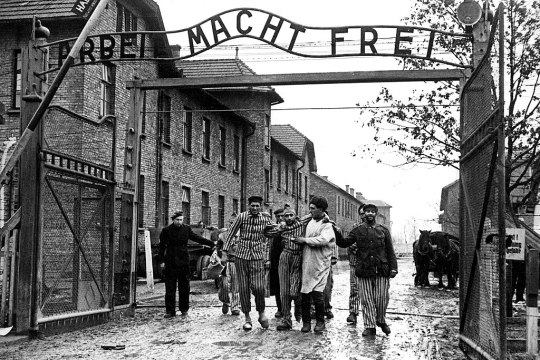
On 27 January 1945, Auschwitz concentration camp—a Nazi concentration camp where more than a million people were murdered—was liberated by the Red Army during the Vistula–Oder Offensive. Although most of the prisoners had been forced onto a death march, about 7,000 had been left behind. The Soviet soldiers attempted to help the survivors and were shocked at the scale of Nazi crimes.
Between 1940 and 1945, about 1.3 million people (mostly Jews) were deported to Auschwitz by Nazi Germany; 1.1 million were murdered. In August 1944, there were more than 135,000 prisoners across the complex. In January 1945, after the Red Army launched the Vistula–Oder Offensive and approached the camp, almost 60,000 prisoners were forced to leave on a death march westward.
Inmates were marched mostly to Loslau but also to Gleiwitz, where they were forced into Holocaust trains and transported to concentration camps in Germany. However, the liberation of the camp was not a specific goal of the Red Army and happened as a consequence of their advance westward across Poland. The Red Army had already liberated concentration camps in the Baltic area in early- to mid-1944, and other concentration camps continued to be liberated until the German surrender and the end of World War II in Europe in May 1945.
Red Army soldiers from the 322nd Rifle Division arrived at Auschwitz on 27 January 1945 at 15:00. Two hundred and thirty-one Red Army soldiers died in the fighting around Monowitz concentration camp, Birkenau, and Auschwitz I, as well as the towns of Oświęcim and Brzezinka. For most of the survivors, there was no definite moment of liberation. After the death march away from the camp, the SS-TV guards had left.
About 7,000 prisoners had been left behind, most of whom were seriously ill due to the effects of their imprisonment. Most of those left behind were middle-aged adults or children younger than 15. Red Army soldiers also found 600 corpses, 370,000 men's suits, 837,000 articles of women's clothing, and seven tonnes (7.7 tons) of human hair. At Monowitz camp, there were about 800 survivors and the camp was liberated also on 27 January by the Soviet 60th Army, part of the 1st Ukrainian Front.
Battle-hardened soldiers who were used to death were shocked by the Nazis' treatment of prisoners. Red Army general Vasily Petrenko, commander of the 107th Infantry Division, remarked, "I who saw people dying every day was shocked by the Nazis' indescribable hatred toward the inmates who had turned into living skeletons. I read about the Nazis' treatment of Jews in various leaflets, but there was nothing about the Nazis' treatment of women, children, and old men. It was in Auschwitz that I found out about the fate of the Jews." In a few articles in Soviet newspapers such as Pravda, following Soviet propaganda, failed to mention Jews in their articles on the liberation.
As soon as they arrived, the liberating forces (assisted by the Polish Red Cross) tried to help survivors by organizing medical care and food; Red Army hospitals cared for 4,500 survivors. There were also efforts to document the camp. As late as June 1945, there were still 300 survivors at the camp who were too weak to be moved.
The date of the liberation (27 January) is recognized by the United Nations and the European Union as International Holocaust Remembrance Day.
*Photo Above: Soviet soldiers liberating Auschwitz concentration camp
Daily inspiration. Discover more photos at http://justforbooks.tumblr.com
#JUST FOR BOOKS#Auschwitz concentration camp#International Holocaust Remembrance Day#322nd Rifle Division
90 notes
·
View notes
Link
1 note
·
View note
Photo
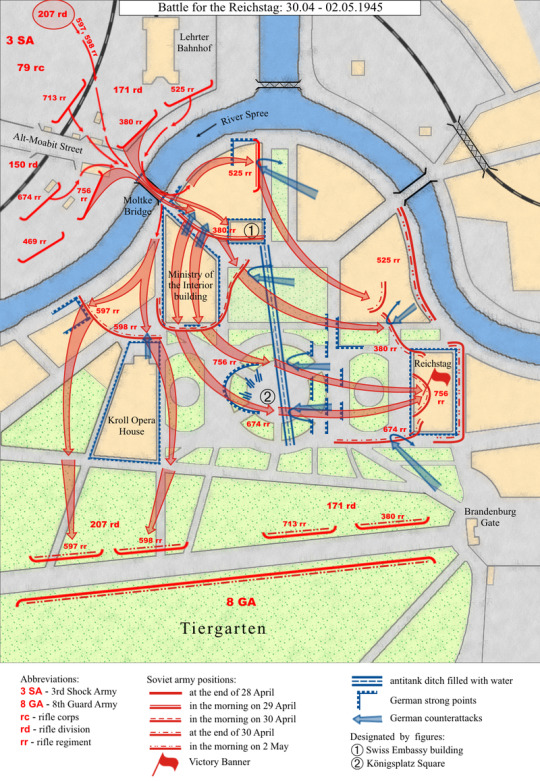
The Battle of Berlin, designated the Berlin Strategic Offensive Operation by the Soviet Union, and also known as the Fall of Berlin, was one of the last major offensives of the European theatre of World War II.[f]
Following the Vistula–Oder Offensive of January–February 1945, the Red Army had temporarily halted on a line 60 km (37 mi) east of Berlin. On 9 March, Germany established its defence plan for the city with Operation Clausewitz. The first defensive preparations at the outskirts of Berlin were made on 20 March, under the newly appointed commander of Army Group Vistula, General Gotthard Heinrici.
When the Soviet offensive resumed on 16 April, two Soviet fronts (army groups) attacked Berlin from the east and south, while a third overran German forces positioned north of Berlin. Before the main battle in Berlin commenced, the Red Army encircled the city after successful battles of the Seelow Heights and Halbe. On 20 April 1945, Hitler's birthday, the 1st Belorussian Front led by Marshal Georgy Zhukov, advancing from the east and north, started shelling Berlin's city centre, while Marshal Ivan Konev's 1st Ukrainian Front broke through Army Group Centre and advanced towards the southern suburbs of Berlin. On 23 April General Helmuth Weidling assumed command of the forces within Berlin. The garrison consisted of several depleted and disorganised Wehrmacht and Waffen-SS divisions, along with poorly trained Volkssturm and Hitler Youth members. Over the course of the next week, the Red Army gradually took the entire city.
On 30 April, Hitler committed suicide (with several of his officials also committing suicide shortly afterwards). The city's garrison surrendered on 2 May but fighting continued to the north-west, west, and south-west of the city until the end of the war in Europe on 8 May (9 May in the Soviet Union) as some German units fought westward so that they could surrender to the Western Allies rather than to the Soviets.
https://en.wikipedia.org/wiki/Battle_of_Berlin
0 notes